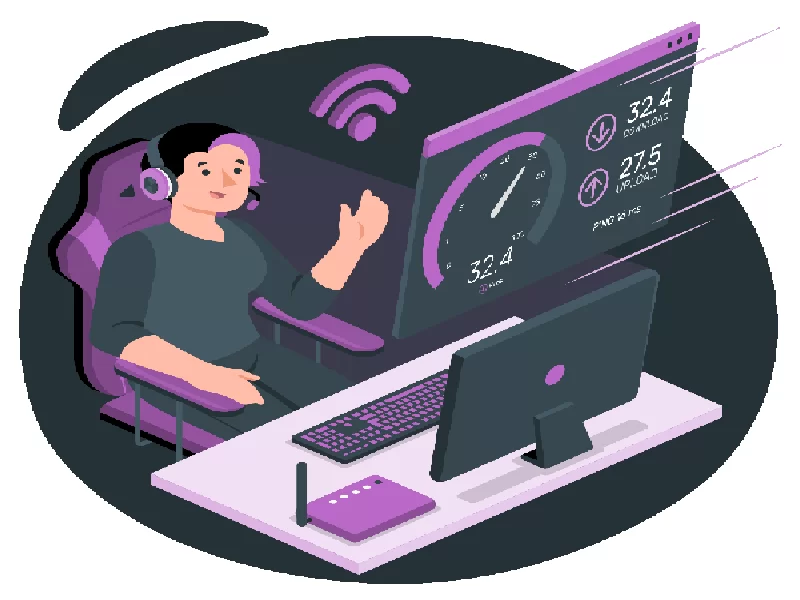- High latency can be caused by factors like network congestion, server distance, Wi-Fi interference, and poor device performance.
- To reduce latency, consider switching to a wired connection, upgrading your router, and choosing servers closer to your location.
High internet latency is one of the most frustrating obstacles to smooth online experiences. Whether you’re gaming, streaming, or working remotely, understanding the underlying causes of latency can help improve your connection. Let’s dive into the hidden factors that contribute to high latency and how they affect your digital life.
Also read: 4 key differences between fibre internet and regular internet
Also read: What is internet latency?
Also read: GABIX expands local Internet infrastructure in Gabon
1. Distance to the server
One of the most significant factors influencing latency is the physical distance between your device and the server you’re connecting to. Every time data travels between you and the server, it takes time. The farther the server, the longer the journey for the data, which directly increases latency. For example, if you’re connecting to a server based in another country, it can add noticeable delay, even if you have a fast connection. Opting for servers closer to your location can significantly reduce this issue.
2. Network congestion
Network congestion occurs when too many users are trying to access the same network at the same time, especially during peak usage periods. This overload causes a backlog of data, resulting in delayed packet delivery. You might notice slow speeds or increased latency when many people are online in your area or if your internet service provider (ISP) is struggling with traffic. This is why latency tends to spike during evenings or weekends when everyone is streaming movies or playing online games.
3. Wi-Fi interference
While Wi-Fi offers convenience, it’s also more susceptible to interference compared to wired connections. Physical barriers such as walls, floors, and furniture can block signals. Additionally, other devices in your home, such as microwaves, baby monitors, and even other Wi-Fi networks, can disrupt your connection. This interference can increase latency, making Wi-Fi less reliable for time-sensitive activities like gaming or video calls. To reduce Wi-Fi-related latency, consider switching to a wired Ethernet connection or placing your router in a central location with fewer obstructions.
4. Poor router or modem quality
Your router or modem is the gateway to your internet connection. If these devices are outdated or malfunctioning, they can introduce delays in data transmission. Routers that are too old or have poor processing power struggle to handle high-speed internet, which directly increases latency. Upgrading to a modern, high-performance router or modem can significantly improve connection speed and reduce delays, especially if you’re using multiple devices at once.
5. Device overload
The performance of the device you’re using to access the internet plays a big role in latency. If your device is running too many applications, has insufficient processing power, or is overwhelmed by background processes, it can slow down your connection. The more tasks your device has to manage, the more likely it is to introduce delays. Regularly closing unnecessary applications or upgrading your device’s hardware can help minimize this issue.
6. Satellite internet
Satellite internet is known for its high latency due to the long distance data must travel between Earth and satellites orbiting in space. This round-trip data journey can add up to 500ms of latency, which makes satellite connections unsuitable for real-time applications like video conferencing or online gaming. While satellite internet has improved, it still faces challenges in offering low-latency connections compared to fiber or cable broadband.
7. Internet Service Provider (ISP) issues
Sometimes, the issue with high latency lies with your ISP. ISPs can throttle your bandwidth during peak times, intentionally slowing down your connection. Additionally, poor network routing, hardware limitations, or routing inefficiencies within the ISP’s infrastructure can contribute to high latency. If you frequently experience slow speeds or high latency, contacting your ISP to inquire about potential issues can help diagnose the problem.
How to reduce latency
To combat high latency, consider these steps:
- Switch to a wired connection: Ethernet cables provide more stability than Wi-Fi.
- Upgrade your router or modem: Choose high-quality devices for better speed and reliability.
- Choose a server closer to your location: This minimizes the distance data must travel.
- Limit network congestion: Reduce bandwidth-heavy activities during peak hours or opt for higher-speed internet plans.
By addressing these hidden culprits, you can optimize your internet connection and reduce frustrating delays, ensuring a smoother experience for gaming, streaming, and remote work.

